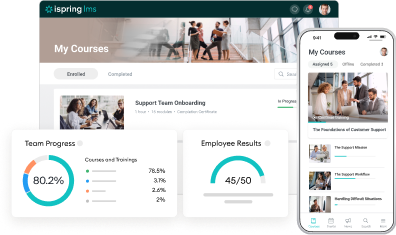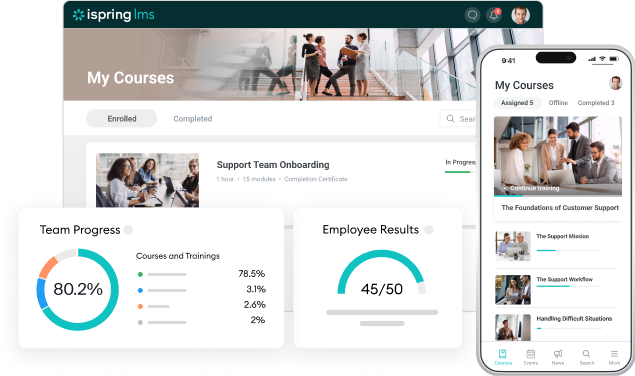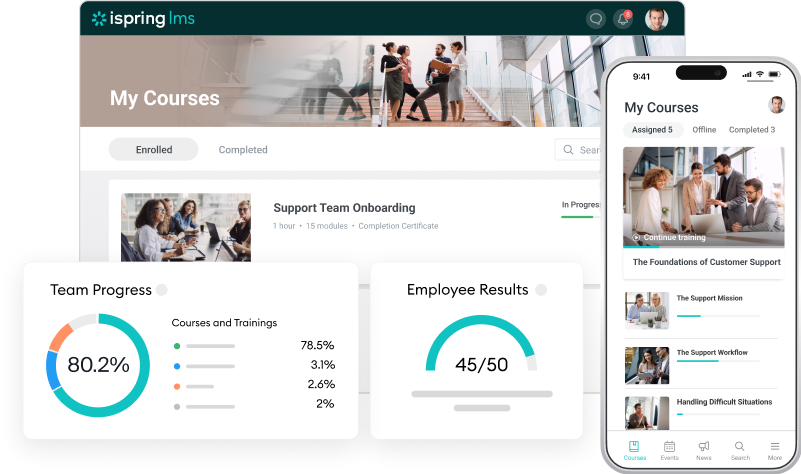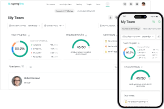LXP vs. LMS: What’s the Difference?

As organizations move their employee training programs online, they often face a choice between two key platform types: a learning management system (LMS) and a learning experience platform (LXP).
Both systems offer efficient ways to support learning and development, but they cater to different training needs and bring unique functionalities and approaches to training management. So, LXP vs. LMS — which one is the best fit for your company?
To answer that, it’s important to understand the key differences between an LMS and an LXP and to identify how each aligns with your vision for corporate training.
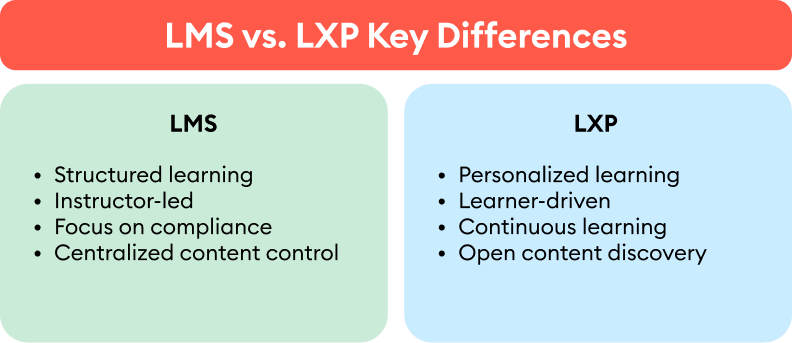
In this article, we’ll explore the core features of an LXP and an LMS, highlight their differences, and provide guidance on choosing the platform that’s best suited to your organization’s needs.
What is an LXP?
A learning experience platform (LXP) is a relatively new player in the world of corporate learning solutions. Unlike traditional learning management systems, which focus on delivering predefined content in a structured way, LXPs are designed to provide a more personalized and self-directed learning experience.
LXPs place the learner in control, using AI and data analytics to curate and recommend content based on the individual’s interests, learning history, and skill gaps.
They transform the learning process from being instructor-led to being learner-driven. Employees can discover learning opportunities on their own, choose from a variety of learning resources (both internal and external), and build their personalized learning paths.
LXP Features
LXPs offer a variety of features that make learning more flexible and learner-driven. Below are some of the most essential ones:
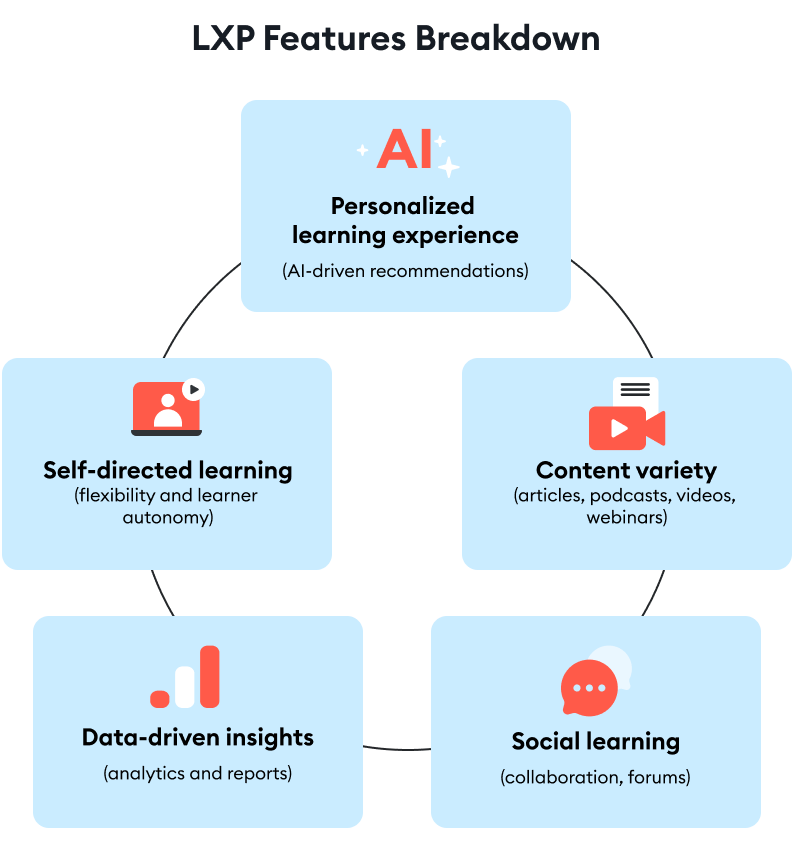
Personalized learning experience
LXPs offer AI-driven content recommendations based on individual learning preferences, career goals, and the employee’s skill gaps. This helps learners stay engaged by providing relevant and timely learning opportunities.
Content variety
A learning experience platform allows access to a diverse range of content, including articles, podcasts, videos, webinars, and social learning experiences. This broad variety of content can be sourced both internally within the organization and externally from the Web, providing a richer learning experience.
Collaborative learning
LXPs foster social learning by allowing learners to engage with peers through discussion forums, group tasks, and other interactive learning activities. Learners can share user-generated content, provide feedback, and learn from each other’s experiences.
Data-driven insights
With built-in analytics, LXPs provide insights into how learners engage with content, which skills they need to develop, and what training resources they prefer. This data helps both learners and managers track progress and fine-tune training programs.
Self-directed learning
LXPs encourage employees to take ownership of their learning process by offering them the flexibility to choose what they learn, when they learn it, and how they engage with content. This approach fosters intrinsic motivation and makes training a continuous, ongoing process.
Benefits of Using an LXP
An LXP can be especially useful in the following ways:
- Fosters a culture of continuous learning. Since LXPs are learner-centric, they are ideal for organizations looking to cultivate a culture of ongoing learning. The personalized and flexible nature of LXPs encourages employees to engage with learning in a way that is most meaningful to them.
- Supports diverse learning preferences. Different employees have different learning preferences. Some prefer reading, while others might favor watching videos or listening to podcasts. An LXP caters to these preferences by offering a wide range of content formats.
- Encourages peer learning. By creating a collaborative environment where employees can share knowledge and experiences, LXPs can drive peer-to-peer learning, which can lead to deeper engagement and enhanced knowledge retention.
What is an LMS?
A learning management system is a tried-and-true platform that provides a centralized and structured approach to managing digital learning content and training programs.
Cloud-based LMSs are particularly effective in situations where formal, structured learning is required, such as compliance training, new employee onboarding, or certification courses.
This type of learning management software enables organizations to create, deliver, and track courses and training modules. Learners follow a set curriculum, and their progress is tracked and reported to administrators, who can then make timely data-driven decisions regarding training needs and outcomes.
LMS Features
Learning management systems come with a variety of features that help organizations manage structured learning programs effectively. Here are some of the most important ones:
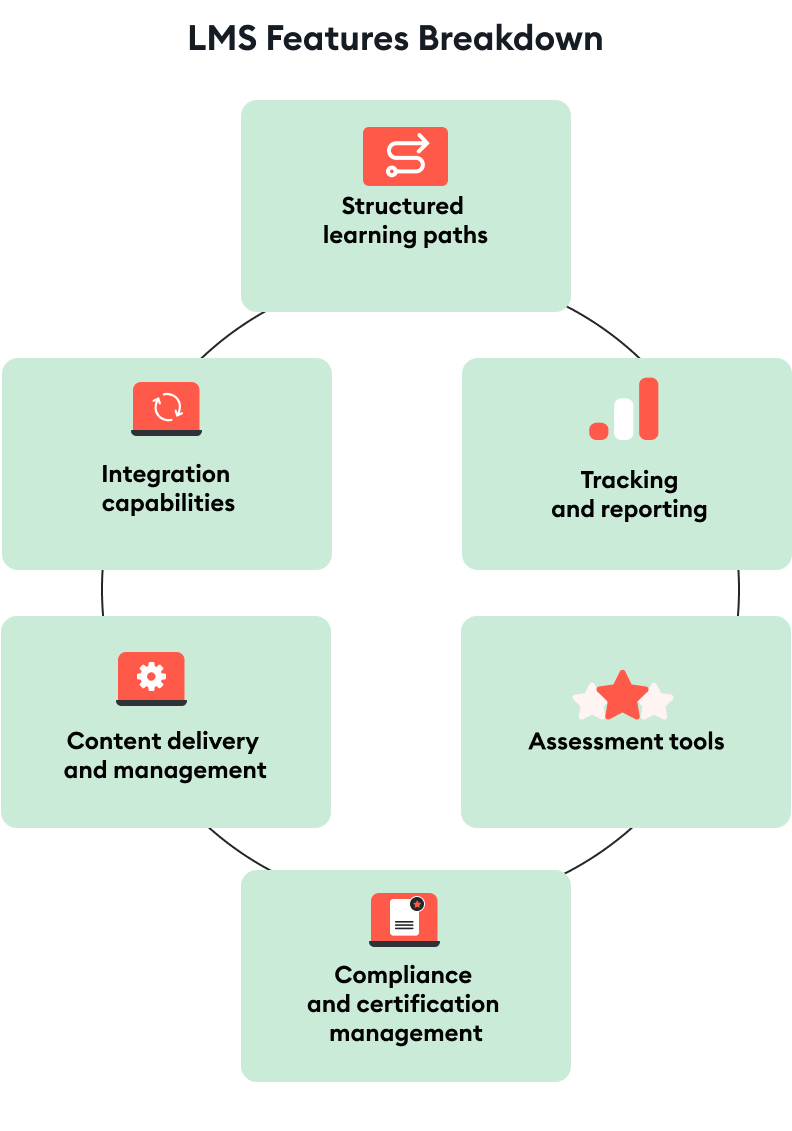
Structured learning paths
LMS platforms are designed to deliver formal, structured courses. These courses typically follow a set curriculum and guide learners through a learning process, step by step. This makes learning management systems ideal for situations in which learners need to achieve specific learning outcomes, such as compliance certifications or product training.
Tracking and reporting
One of the standout features of an LMS is its ability to collect training data, track learner progress, and provide detailed reports on course completion rates, assessment results, and engagement levels of students. These insights are crucial for managers and administrators who need to evaluate the effectiveness of training programs.
Assessment tools
An LMS includes tools for creating quizzes, tests, and assessments that help track learner progress and identify skills gaps. These assessment tools allow organizations to ensure that their employees are retaining the information being taught and can apply it in their job tasks.
Compliance and certification management
For industries where compliance training is essential, an LMS is a must-have. It ensures that all employees follow the required training paths and provides certificates upon successful completion. The LMS can also automate reminders and track compliance over time.
Content delivery and management
An LMS allows organizations to centralize their training content in a single location, facilitating the delivery of courses, materials, and resources to employees across the organization. This centralization also makes it easier for administrators to update courses as needed and ensure consistency throughout the company.
Integration capabilities
Most learning management systems integrate with other tools, such as webinar platforms for instructor-led training, HR systems, or content authoring and sharing tools. This integration ensures that training programs are aligned with other organizational processes, such as performance management or professional development initiatives.
Benefits of Using an LMS
An LMS is an excellent choice for organizations that need:
- Structured training programs. For industries that require formal training, such as healthcare, manufacturing, or financial services, an LMS is essential. It ensures that all employees receive the same training, follow the same processes, and satify regulatory requirements.
- Employee onboarding. An LMS is ideal for onboarding new employees, as it allows companies to create standardized onboarding courses that ensure every new hire receives the same essential training.
- Tracking and reporting. With an LMS, administrators can easily monitor employee progress, so that training programs are always on track and employees are meeting the required standards.
LMS vs. LXP: Which Platform to Choose?
The decision between an LMS and an LXP largely depends on the specific training needs of your organization. While both types of learning platforms have their merits, they cater to different aspects of learning and development.
Structured learning and compliance
If your business or organization needs formal, structured training with detailed tracking and reporting, an LMS is the ideal solution. An LMS like iSpring LMS allows you to create structured courses that ensure all employees follow the same learning path, making it perfect for onboarding, compliance training, and certification.
Personalized, self-directed learning
If your organization values continuous, learner-driven development, an LXP may be the best option. LXPs are generally better at providing personalized learning experiences, since they offer curated educational content based on learner preferences.
However, the choice is not always black-and-white. Some organizations find that a hybrid approach works best, using an LMS for structured training courses and an LXP for more informal, self-directed learning.
This dual approach ensures that employees have access to both formal and informal learning opportunities, helping them grow in a variety of ways.
Do You Need to Choose Between an LMS and an LXP?
While many organizations feel they must choose between one or the other, the good news is that you don’t always have to make that decision.
There’s a growing trend where learning management systems are adopting features traditionally seen in LXPs to provide the best of both worlds. This means you can have the structured, trackable learning offered by an LMS, while also benefiting from the personalized, flexible learning experiences of an LXP.
iSpring LMS is a great example of this blend. It started as a SCORM-compliant LMS and now incorporates some of the key features of an LXP, giving you the tools to deliver effective corporate training, while keeping things engaging and learner-friendly.

How iSpring combines LMS and LXP features
iSpring LMS is a learning ecosystem that’s designed to provide users with the structured approach of an LMS while incorporating the flexibility and personalized features of an LXP. Here are some of the key features that make this possible:
1. Detailed reporting tools
Like any advanced LMS, iSpring LMS offers robust tracking and reporting capabilities.
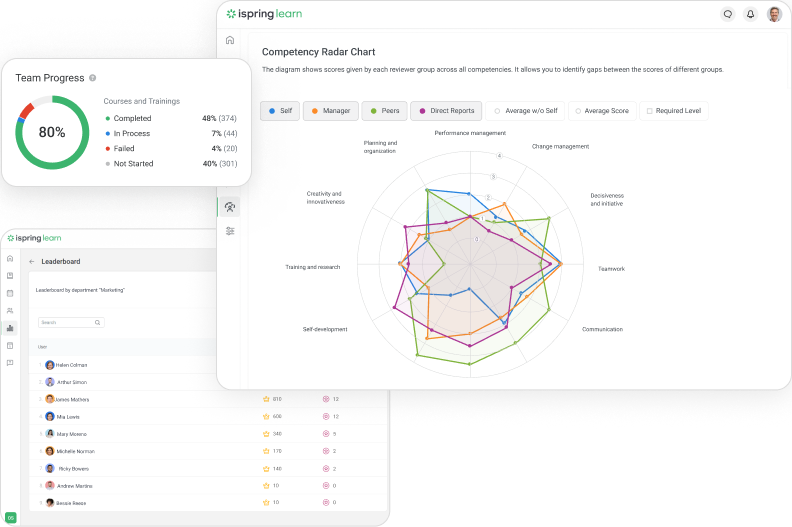
You can monitor employee progress, evaluate employees’ soft skills, ensure compliance, and create reports that give you a clear picture of how your training programs are performing.
2. Easy course creation
With built-in or bundled course creation tools, like a powerful iSpring Suite authoring tool, it’s easy to design the exact training your team needs: from full-fledged interactive courses and assessments to training videos, scenarios, and microlearning courses.

Thanks to an intuitive interface and an AI assistant, anyone can create engaging learning experiences quickly and easily.
3. Personalized learning paths
While structured learning is key, iSpring LMS also offers the flexibility to tailor learning pathways based on each employee’s needs. This personal touch makes the training more relevant to the learner, much like the approach taken by an LXP.

- Social learning and collaboration
iSpring LMS incorporates social learning features that allow workers to share knowledge, ask questions, and learn from each other. This makes training more interactive and community-driven, which helps learners stay engaged and motivated.
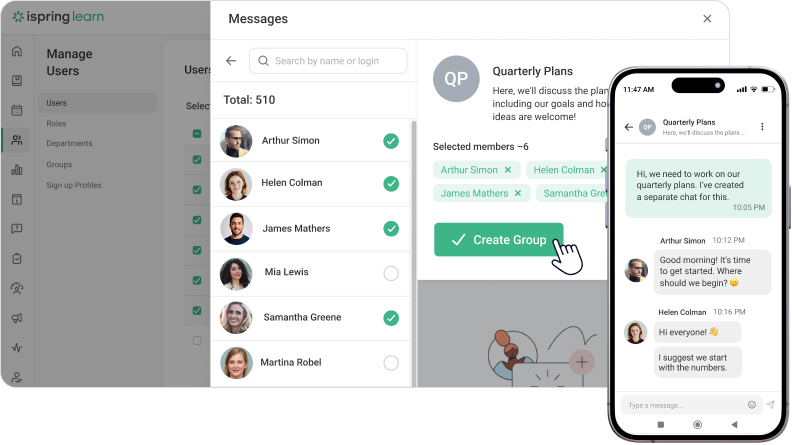
5. Newsfeed and push notifications
Similar to an LXP, iSpring LMS has a newsfeed feature that works like corporate social media and keeps learners informed about the latest training materials, course updates, and important announcements. It helps employees stay on track and never miss out on new learning opportunities.

6. Access to a wide range of courses
iSpring LMS comes with a library of ready-made courses. Plus, you can integrate external content from other platforms, giving learners a broader range of resources to choose from.
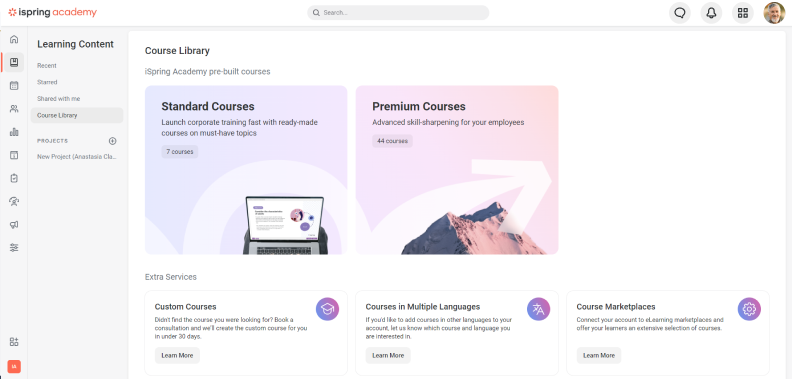
Whether it’s internal training or third-party courses, learners can access what they need, all in one place.
Why platforms like iSpring LMS are the best of both worlds
With a platform like iSpring LMS, you don’t have to compromise between the structure of an LMS and the flexibility of an LXP. You get a learning platform that’s perfect for delivering formal, structured training, while also offering the flexibility, personalization, and engagement that today’s learners expect.
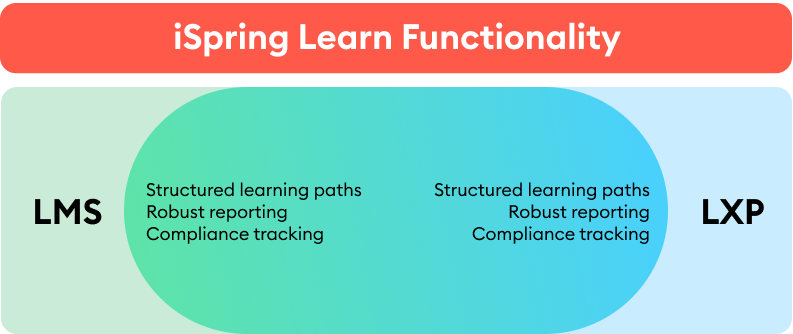
So, if you’re looking for a solution that covers all your training needs — whether it’s onboarding, compliance, or continuous development — iSpring LMS has you covered. It’s an LMS that combines the best of both worlds, making it easier for your team to succeed.
Try iSpring LMS today and see how it can transform your corporate training with the best features of both an LMS and an LXP.
FAQ
What are the key differences between an LMS and an LXP?
The main difference lies in their approach to learning. An LMS focuses on delivering structured, formal courses, whereas an LXP emphasizes personalized, self-directed learning. LMS platforms are great for compliance, certifications, and onboarding, while LXPs are ideal for fostering a culture of continuous learning through personalized content recommendations.
Which is better for corporate training, an LMS or an LXP?
That depends on your organization’s needs. An LMS is better for formal, structured training programs like onboarding, compliance, and certifications. An LXP is better for personalized, self-directed learning, where employees can choose the content they engage with based on their interests and career goals.
How do I choose between an LMS and an LXP for my organization?
Consider the type of training your organization requires. If you need a formal learning structure with compliance tracking, go with an LMS. If you’re looking to encourage continuous, learner-driven development, an LXP might be the better choice.
Making the Right Choice for Your Organization
Choosing between an LMS and an LXP ultimately depends on your organization’s unique training needs. If your priority is to create structured learning programs that are easy to track and monitor, an LMS will serve you well. On the other hand, if you’re focused on providing a more personalized, self-directed learning experience, an LXP might be the better fit.
However, with modern learning technology like iSpring LMS, you don’t have to choose LXP vs. LMS and limit yourself to just one approach. You can benefit from the solid structure of a learning management system while incorporating flexible, learner-driven features that make training more engaging and relevant for your team.
iSpring LMS offers the perfect blend of functionality, making it a versatile solution for companies that want to cover all bases — from compliance and certifications to fostering continuous, self-motivated learning.
Get the best of both worlds with iSpring LMS’s combined LMS and LXP features. Try it for free today and see how it transforms your corporate training.



